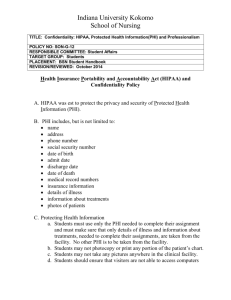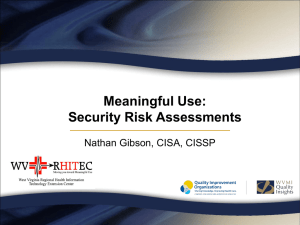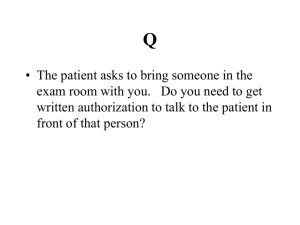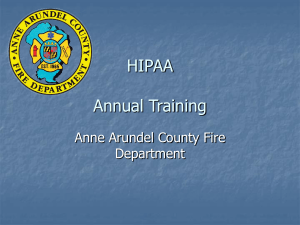Communication of PHI Policy Doc
advertisement
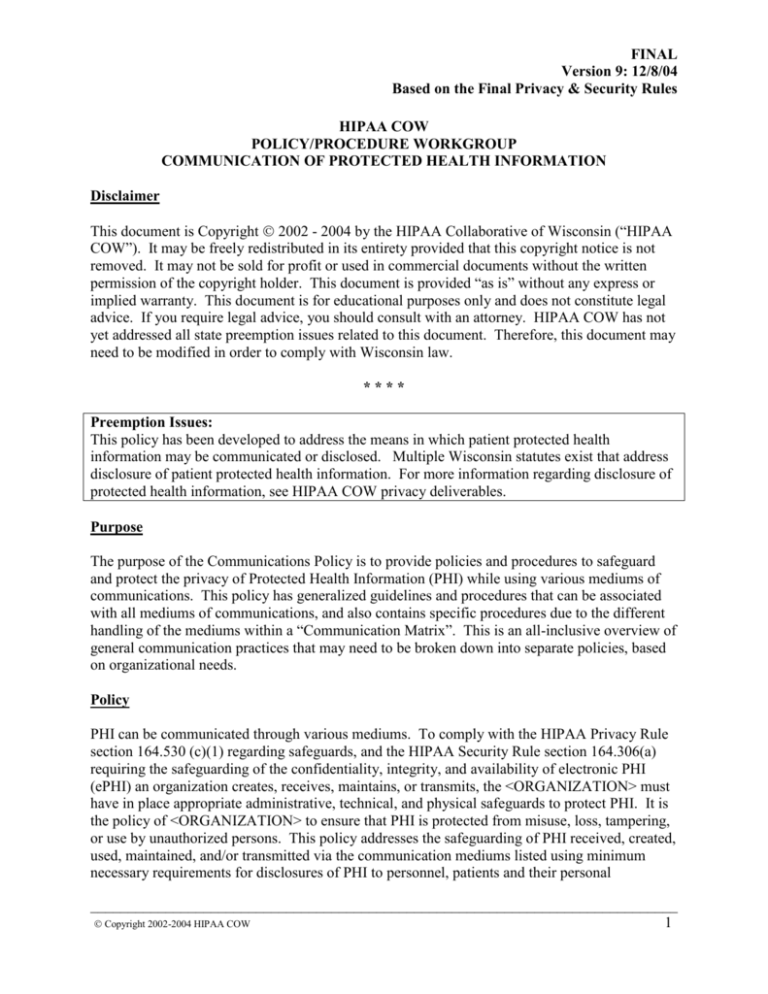
FINAL Version 9: 12/8/04 Based on the Final Privacy & Security Rules HIPAA COW POLICY/PROCEDURE WORKGROUP COMMUNICATION OF PROTECTED HEALTH INFORMATION Disclaimer This document is Copyright 2002 - 2004 by the HIPAA Collaborative of Wisconsin (“HIPAA COW”). It may be freely redistributed in its entirety provided that this copyright notice is not removed. It may not be sold for profit or used in commercial documents without the written permission of the copyright holder. This document is provided “as is” without any express or implied warranty. This document is for educational purposes only and does not constitute legal advice. If you require legal advice, you should consult with an attorney. HIPAA COW has not yet addressed all state preemption issues related to this document. Therefore, this document may need to be modified in order to comply with Wisconsin law. **** Preemption Issues: This policy has been developed to address the means in which patient protected health information may be communicated or disclosed. Multiple Wisconsin statutes exist that address disclosure of patient protected health information. For more information regarding disclosure of protected health information, see HIPAA COW privacy deliverables. Purpose The purpose of the Communications Policy is to provide policies and procedures to safeguard and protect the privacy of Protected Health Information (PHI) while using various mediums of communications. This policy has generalized guidelines and procedures that can be associated with all mediums of communications, and also contains specific procedures due to the different handling of the mediums within a “Communication Matrix”. This is an all-inclusive overview of general communication practices that may need to be broken down into separate policies, based on organizational needs. Policy PHI can be communicated through various mediums. To comply with the HIPAA Privacy Rule section 164.530 (c)(1) regarding safeguards, and the HIPAA Security Rule section 164.306(a) requiring the safeguarding of the confidentiality, integrity, and availability of electronic PHI (ePHI) an organization creates, receives, maintains, or transmits, the <ORGANIZATION> must have in place appropriate administrative, technical, and physical safeguards to protect PHI. It is the policy of <ORGANIZATION> to ensure that PHI is protected from misuse, loss, tampering, or use by unauthorized persons. This policy addresses the safeguarding of PHI received, created, used, maintained, and/or transmitted via the communication mediums listed using minimum necessary requirements for disclosures of PHI to personnel, patients and their personal ______________________________________________________________________________ Copyright 2002-2004 HIPAA COW 1 FINAL Version 9: 12/8/04 Based on the Final Privacy & Security Rules representatives, other covered entities, public health officials, business associates, etc. set forth by federal, state and local laws (refer to <ORGANIZATION’S> Release of Information Policy). Verification of identity is attained in accordance with the Identity Verification Policy prior to release of PHI. Accounting of disclosures of PHI is maintained in compliance with <ORGANIZATION’S> Policy. Transmission of ePHI over the organization’s own network is managed with internal controls such as unique user ID and Password authentication (refer to System Access Policy). Definitions Encryption: the use of an algorithmic process to transform data into a form in which there is a low probability of assigning meaning without use of a confidential process or key. Protected Health Information (PHI): Individually identifiable health information that is created by or received by the organization, including demographic information, that identifies an individual, or provides a reasonable basis to believe the information can be used to identify an individual, and relates to: Past, present or future physical or mental health or condition of an individual. The provision of health care to an individual. The past, present, or future payment for the provision of health care to an individual. Content Communication will be clear, concise, and professional. Emotional content, such as anger, sarcasm, harsh criticism, irony, incriminating remarks, and libelous references to third parties is not allowed. Employees should not expect communications they send to be private. Any material sent via <ORGANIZATION’S> equipment is the property of <ORGANIZATION>. Any violations of this policy will be referred to human resources for disciplinary action. Classification of Information for <ORGANIZATION> General Public Information: Any information that can be given to the general public and can be distributed outside of the <ORGANIZATION> without any risk, through the various mediums. This is often general information about the <ORGANIZATION> for marketing or product purposes. Internal Information Within the <ORGANIZATION>: Information that will not seriously impact or adversely affect <ORGANIZATION> if disclosed about patients, employees or business associates without proper consent or unauthorized disclosure. This may be information such as directories with phone listings, policy manuals that do not disclose PHI of individual patients, and patient educational information. ______________________________________________________________________________ Copyright 2002-2004 HIPAA COW 2 FINAL Version 9: 12/8/04 Based on the Final Privacy & Security Rules Non-sensitive and/or Non-urgent PHI: PHI that can be given by various media, (refer to <ORGANIZATION’S> Release of Information Policy). This information may be used internally within <ORGANIZATION> and received by the patient, guardian, and/or authorized personal representatives (refer to <ORGANIZATION> Release of Information Policy for appropriate release processes). Unauthorized disclosure could adversely impact the <ORGANIZATION>, patients, employees and business associates. The following are examples: Prescription refills, Instructions on how to take medications or apply dressings, Appointment scheduling, Appointment reminders, Normal test results (other than HIV test results) with interpretation and advice, Care and treatment recommendations, Pre- and postoperative instructions, Insurance and billing questions, As a secondary means of attempting to have patients call the provider to discuss important test results and/or prognosis of a condition, Sensitive and/or Urgent Confidential PHI: Sensitive and/or urgent confidential PHI that is intended strictly for use within <ORGANIZATION> and disclosed only to patients or other entities as required by law (refer to <ORGANIZATION’S> Release of Information Policy). Unauthorized disclosure could seriously and adversely impact <ORGANIZATION>, patients, employees and business associates. Obtain an appropriate authorization for disclosures of PHI in this capacity. The following are examples: STD and HIV test results and/or treatment, First means of notification for confusing or abnormal diagnostic results Mental health issues, Drug and alcohol abuse and/or treatment, Child abuse and/or neglect, Domestic abuse, Peer review or risk management information For marketing and fundraising purposes except when allowed by law (refer to <ORGANIZATION> Marketing and Fundraising policies), and exercise caution for urgent/time sensitive matters. Procedures The following Communication Matrix shows specific procedures in handling the various mediums of communicating information. ______________________________________________________________________________ Copyright 2002-2004 HIPAA COW 3 FINAL Version 9: 12/8/04 Based on the Final Privacy & Security Rules CLASSIFICATION OF INFORMATION FOR <ORGANIZATION> General Public Information Internal Information Risk Impact 1. Oral Mediums of Communication a. Conversations b. Telephone c. Cell Phone d. Answering Machines (refer to Appendix 1) e. Overhead Pages f. Lobby Announcements None No serious or adverse affect No specific precautions Reasonable measures should be taken Non-sensitive and/or Non-urgent PHI Active measures taken to prevent the unauthorized disclosure of information from being released If patient has notified <ORGANIZATION> by which means to give PHI, must be noted in their medical record and adhered to Verification of identity must be attained in accordance with the Identity Verification Policy Document the release in accordance with the Accounting of Disclosures Policy Could result in adverse impact or have possible penalties applied Conduct PHI in private settings and use lowered voices, avoiding public areas whenever possible. If a patient name is needed, first name only basis (when possible) Do not use a speakerphone for discussion of PHI nor retrieval of voice mail (unless in a private, closed office) Limit discussions of PHI using a cell phone. Consider that older cell phones are not secure. Refer to Appendix 1 for leaving messages on an answering machine Pages and announcements are used only to call the operator back ______________________________________________________________________________ Copyright 2002-2004 HIPAA COW 4 Sensitive and/or Urgent Confidential PHI This information may not be released without a separate signed authorization for releasing this specific information If patient has notified <ORGANIZATION> by which means to give PHI, must be noted in their medical record and adhered to Verification of identity must be attained in accordance with the Identity Verification Policy Document the release in accordance with the Accounting of Disclosures Policy Likely have a serious adverse impact. Penalties very likely to occur and could result in loss of business Discuss PHI in a controlled manner to limit being overheard, such as in an enclosed area If a patient name is needed, first name only basis (when possible) Do not use a speakerphone for discussion of PHI nor retrieval of voice mail (unless in a private, closed office) Limit discussions of PHI using a cell phone. Consider that older cell phones are not secure. Refer to Appendix 1 for leaving messages on an answering machine Pages and announcements are used only to call the operator back FINAL Version 9: 12/8/04 Based on the Final Privacy & Security Rules General Public Info. 2. Mail a. Internal b. External No specific precautions Internal Information Information of this nature should be out of the general public areas and not accessible by anyone else, but employees. Non-sensitive and/or Non-urgent PHI Sensitive and/or Urgent Confidential PHI Information being sent meets the minimum necessary requirement for disclosure Authorized, trained personnel should handle all mail Clearly label with recipient’s name and address information is correct Mailing item is labeled with Confidential Tracking mechanism is recommended for external mail Store all unattended mail in a closed, secure area Place all types of media containing any form of phi in secured, confidential envelopes and/or containers (internal & external) Return address on external mail consists of <ORGANIZATION> name only. Envelope will not contain the department’s name, provider’s name (unless this is the name of the organization, nor the identity of the enclosed information. For tracking purposes, internal codes may be included on envelopes as long as it does not in any way relinquish the identity of the department and/or provider to anyone outside of <ORGANZIATION> ______________________________________________________________________________ Copyright 2002-2004 HIPAA COW 5 Information being sent meets the minimum necessary requirement for disclosure Authorized, trained personnel should handle all mail Clearly label with recipient’s name and address information is correct Mailing item is labeled with Restricted Confidential If external, delivery of information and tracking mechanisms is required (FEDEX, messenger, certified, etc…) Store all unattended mail in a closed, secure area Place all types of media containing any form of PHI in secured, confidential envelopes and/or containers (internal & external) Return address on external mail consists of <ORGANIZATION> name only. Envelope will not contain the department’s name, provider’s name (unless this is the name of the organization, nor the identity of the enclosed information. For tracking purposes, internal codes may be included on envelopes as long as it does not in any way relinquish the identity of the department and/or provider to anyone outside of <ORGANZIATION> FINAL Version 9: 12/8/04 Based on the Final Privacy & Security Rules General Public Info. 3. Faxes Located in a secure area out of the general public Use a coversheet with confidentiality statement Use reasonable efforts to dial correct number When using a means to store fax numbers, verify the number with the receiver Internal Information Located in a secure area out of the general public Use a coversheet with confidentiality statement Use reasonable efforts to dial correct number When using a means to store fax numbers, verify the number with the receiver Non-sensitive and/or Non-urgent PHI Sensitive and/or Urgent Confidential PHI Located in an area not accessible by the public Coversheet with confidentiality statement used Use reasonable efforts in dialing correct number (i.e. testing number before sending phi), preference to using pre-programmed, labeled numbers When using a means to store fax numbers, verify the number with the receiver Only personnel with access to restricted area may access these faxes (review <ORGANIZATION’S> Minimum Necessary Policy). Trained workforce member routinely checks fax machine and distributes to appropriate personnel Faxes transmitted in error: contact person who received the fax to verify destruction of the fax and notated in patient’s medical record. Report the breach to the Privacy Officer Utilize a mechanism to ensure that the transmission went to the intended recipient (Fax logs, verification by phone, etc…) If you receive a fax in error, immediately inform the sender and destroy the information received Consider storing faxes in a queue until staffed. ______________________________________________________________________________ Copyright 2002-2004 HIPAA COW 6 Located in an area not accessible by the public Coversheet with confidentiality statement used Use reasonable efforts in dialing correct number (i.e. testing number before sending phi), preference to using pre-programmed, labeled numbers When using a means to store fax numbers, verify the number with the receiver Call prior to faxing to notify recipient of expected confidential fax Information is immediately routed to appropriate personnel Only personnel with access to restricted area may access these faxes (review <ORGANIZATION’S> Minimum Necessary Policy). Trained workforce member routinely checks fax machine and distributes to authorized personnel Faxes transmitted in error: contact person who received the fax to verify destruction of the fax and notated in patient’s medical record. Report the breach to the Privacy Officer. Utilize a mechanism to ensure that the transmission went to the intended recipient (Fax logs, verification by phone, etc…) If you receive a fax in error, immediately inform the sender and destroy the information received Consider storing faxes in a queue until staffed. FINAL Version 9: 12/8/04 Based on the Final Privacy & Security Rules General Public Info. 4. E-mail a. Refer to the System Access Policy b. Refer to the E-mail Whitepaper c. Refer to Appendix 3 Guidelines for E-mailing PHI d. Refer to Appendix 4 Sample Patient E-Mail Acceptance Form E-mails may be used for business purposes only Confidential ity statement attached to every email Out-ofoffice replies are activated during absences of more than 48 hours. Internal Information E-mails may be used for business purposes only Information of this nature should be out of the general public areas and not accessible by anyone else, but employees. Confidentiality statement attached to every email Out-of-office replies are activated during absences of more than 48 hours. If the information is time-sensitive, verify receipt of email. Non-sensitive and/or Non-urgent PHI Sensitive and/or Urgent Confidential PHI Prior to sending an e-mail to a patient a signed patient E-mail Informed Consent Form is received, filed in patient’s medical record, and adhered to (refer to Appendix 4) Utilize <ORGANIZATION’S> e-mail application at all times 128 bit encryption [164.312(a)(2)(iv) & 164.312(e)(2)(ii)] Utilize only pre-stored addresses Verify email address prior to storing the address Use discrete, generic subject headers. Do not include the patient’s name in the subject header List sender’s name, title, email address, telephone number, and party who patient may contact with further questions Attach the Confidentiality statement to every email Group emails will only be sent in the following situations when utilizing the bcc function: impending shutdown for network maintenance, technical difficulties, recent mail blackouts, new services, change of address and/or telephone number, and change in hours If the information is time-sensitive, verify receipt of email. Workforce member routinely checks emails and replies to messages within 48 hours of receipt Copy of the email, including replies and receipt confirmations are filed in ______________________________________________________________________________ Copyright 2002-2004 HIPAA COW 7 Prior to sending an e-mail to a patient a signed patient E-mail Informed Consent Form is received, filed in patient’s medical record, and adhered to (refer to Appendix 4) Utilize <ORGANIZATION’S> e-mail application at all times 128 bit encryption [164.312(a)(2)(iv) & 164.312(e)(2)(ii)] Utilize only pre-stored addresses Verify email address prior to storing the address Use discrete, generic subject headers. Do not include the patient’s name in the subject header List sender’s name, title, email address, telephone number, and party who patient may contact with further questions Attach the Confidentiality statement to every email Group emails will only be sent in the following situations when utilizing the bcc function: impending shutdown for network maintenance, technical difficulties, recent mail blackouts, new services, change of address and/or telephone number, and change in hours. If the information is time-sensitive, verify receipt of email. Workforce member routinely checks emails and replies to messages within 48 hours of receipt Copy of the email, including replies and receipt confirmations are filed in FINAL Version 9: 12/8/04 Based on the Final Privacy & Security Rules General Public Info. Internal Information Email Cont…. Non-sensitive and/or Non-urgent PHI 5. PDA’s Refer to the System Access policy No specific precautions Information of this nature should be out of the general public areas and not accessible by anyone else, but employees. Sensitive and/or Urgent Confidential PHI patient’s medical records Out-of-office replies with instructions on whom to contact for immediate assistance are activated during absences of more than 48 hours If PHI was sent to wrong recipient, notate and document this in the Patient’s medical record. Report the breach to the Privacy Officer Password protection required, limit number of login attempts 128 bit encryption [164.312(a)(2)(iv) & 164.312(e)(2)(ii)] Antivirus software should be in place Training to staff member with possession of PDA on situations that PDA is lost or stolen Provide disaster recovery mechanisms If information is not required to travel off-site or not used, then store PDA in a locked area that is out of site Information contained in <ORGANIZATION’S> system may only be downloaded onto a PDA owned by <ORGANIZATION>, not onto a user’s personal PDA ______________________________________________________________________________ Copyright 2002-2004 HIPAA COW 8 patient’s medical records Out-of-office replies with instructions on whom to contact for immediate assistance are activated during absences of more than 48 hours If PHI was sent to wrong recipient, notate and document this in the Patient’s medical record. Report the breach to the Privacy Officer Password protection required, limit number of login attempts 128 bit encryption [164.312(a)(2)(iv) & 164.312(e)(2)(ii)] Antivirus software should be in place Training to staff member with possession of PDA on situations that PDA is lost or stolen Provide disaster recovery mechanisms If information is not required to travel off-site or not used, then store PDA in a locked area that is out of site Information contained in <ORGANIZATION’S> system may only be downloaded onto a PDA owned by <ORGANIZATION>, not onto a user’s personal PDA FINAL Version 9: 12/8/04 Based on the Final Privacy & Security Rules General Public Info. 6. Transporting Medical Records No specific precautions Internal Information Information of this nature should be out of the general public areas and not accessible by anyone else, but employees Non-sensitive and/or Non-urgent PHI Sensitive and/or Urgent Confidential PHI Utilize courier bags with a closure mechanism (ex. Velcro, taped, tote with a lid, etc.) Documentation (Sign out sheet or tracking sheet) for all medical records that leave the facility. Date, who took the medical record, destination location, who received the medical record and a return date, should be on this form. Medical records are to be promptly returned upon completion of use. Utilize <ORGANIZATION’S> courier service whenever possible. Cab or delivery service is only used as a last resort. If cab or delivery service is used, place the medical record in a sealed envelope or container. Request the receiver to contact the sender as soon as the chart arrives at the proper destination ______________________________________________________________________________ Copyright 2002-2004 HIPAA COW 9 Utilize courier bags with a closure mechanism (ex. Velcro, taped, tote with a lid, etc.) Documentation (Sign out sheet or tracking sheet) for all medical records that leave the facility. Date, who took the medical record, destination location, who received the medical record and a return date, should be on this form. Medical records are to be promptly returned upon completion of use. Utilize <ORGANIZATION’S> courier service whenever possible. Cab or delivery service is only used as a last resort. If cab or delivery service is used, then place the medical record in a sealed envelope. Request the receiver to contact the sender as soon as the chart arrives at the proper destination FINAL Version 9: 12/8/04 Based on the Final Privacy & Security Rules References 45 CFR 164.306 45 CFR 164.312(a)(2)(iv) 45 CFR 164.312(e)(2)(ii) 45 CFR 164.501 45 CFR 164.502 45 CFR 164.508 45 CFR 164.514 (d-f, h) 45 CFR 164.520(b)(1)(iii)(A) 45 CFR 164.522(a-b) 45 CFR 164.528 45 CFR 164.530(c)(1) WI Statutes 51.30, 102.13, 146.81-146.84 and 252.15 Association of American Medical Colleges – E-mail host security standard sample Association of American Medical Colleges – Media and hardcopy protection and transportation standard sample American Medical Association – Guideline for Physician-Patient Electronic Communications (last updated 5/8/02) Journal of AHIMA – Practice Brief: E-mail Security (February 2000) SANS Institute – Securing PDAs in the Health Care Environment (09/06/02) HIMSS 2002 Conference – HandHelds, The Holy Grail of Healthcare (Presented by Neil Smithline, MD, FACP) Hawaii Health Information Corporation – Data Classification Policy Authors Damian R. Minczeski, MBA, CHCC Holly Schlenvogt, MSH Suzanne Ronde, Consultant Reviewed by HIPAA COW Policy Workgroup HIPAA COW Administrative Workgroup HIPAA COW Technical Security Workgroup HIPAA COW Physical Security Workgroup Attachments Appendix 1: Sample Messages For Answering Machines Appendix 2: Sample Fax Cover Sheet Appendix 3: Guidelines for E-mailing PHI Appendix 4: Sample Patient E-mail Informed Consent Form ______________________________________________________________________________ Copyright 2002-2004 HIPAA COW 11 FINAL Version 9: 12/8/04 Based on the Final Privacy & Security Rules APPENDIX 1 SAMPLE MESSAGES FOR ANSWERING MACHINES 1. “This is <ORGANIZATION> office calling to remind <FIRST NAME OF PATIENT> of his/her appointment <DATE> at <TIME>. If you have any questions, please call us at 111111-1111. Thank you.” 2. “This is <ORGANIZATION OR DOCTOR> office calling regarding the information that <FIRST NAME OF PATIENT> requested. Would you please ask <FIRST NAME OF PATIENT> to call <ORGANIZATION OR DOCTOR> at <CONTACT PHONE NUMBER>” ______________________________________________________________________________ Copyright 2002-2004 HIPAA COW 12 FINAL Version 9: 12/8/04 Based on the Final Privacy & Security Rules APPENDIX 2 SAMPLE FAX COVER SHEET <ORGANIZATION> LOGO FAX TRANSMISSION DATE: FAX: TO: PHONE: PATIENT: SENT BY: Department Name – <ORGANIZATION> Name Street Address – City, State, ZIP Departmental Phone Number COMMENTS: You are being faxed a total of _______ pages, including this cover sheet. If you do not receive the entire number of pages or if there are problems with the quality or legibility, please contact the above person at the department/phone number listed above. CONFIDENTIALITY NOTICE The documents accompanying this fax transmission contain confidential patient health information that is legally privileged. This information is intended only for the use of the individual or entity named above. The authorized recipient of this information is prohibited from disclosing information to any other party unless required or allowed to do so by law or regulation and is required to destroy the information after its stated need has been fulfilled. If you are not the intended recipient, you are hereby notified that any disclosure, copying, distribution or action taken in reliance on the contents of these documents is strictly prohibited. If you have received this information in error, please notify the sender immediately and arrange for the return or destruction of these documents. List Information Sent: ______________________________________________________________________________ Copyright 2002-2004 HIPAA COW 13 FINAL Version 9: 12/8/04 Based on the Final Privacy & Security Rules APPENDIX 3 GUIDELINES FOR E-MAILING PHI 1. E-mail Communications should not replace face-to-face encounters between providers and patients, but should be used to supplement and enhance existing relationships. Organizations need to determine if limitations for e-mail communications should be restricted to general patient information, such as scheduling, routine follow up inquiries, prescription refills, and reporting of self-monitoring measurements such as blood pressure and glucose readings. 2. Verify the “To:” e-mail address field is correct (address the patient provided). 3. Ensure the subject header is discrete as to the content of the e-mail (ex. “About your Blood test” is not acceptable). 4. Include an e-mail header at the top of the message stating “This is a CONFIDENTIAL medical communication and is not to be duplicated or forwarded to other individuals or organizations”. 5. List your name, title, e-mail address, and telephone number 6. Include who the patient may contact with further questions, including a name, e-mail address, and telephone number. 7. Send e-mail messages to patients only after verifying receipt of a signed E-mail Acceptance form. 8. Place <ORGANIZATION’S> e-mail confidentiality statement at the end of every e-mail. Sample confidentiality statement: This electronic message, including all attachments, is intended only for the use of the addresse(s) named above and may contain legally privileged and confidential information. The authorized recipient of this information is prohibited from disclosing this information to any other party unless required to do so by law or regulation and is required to destroy the information after its stated need has been fulfilled. If you received this message in error, you may not use, disclose, copy, or disseminate any of the information contained in this message. Please notify the sender by reply e-mail and destroy the original message including all attachments. Thank you for your cooperation. 9. All messages created, sent, or retrieved over <ORGANIZATION’S> network is the property of <ORGANIZATION>, should be considered public information, and may be monitored at any time by <ORGANIZATION>. 10. <ORGANIZATION> will routinely audit e-mail communications to ensure compliance with this policy. ______________________________________________________________________________ Copyright 2002-2004 HIPAA COW 14 FINAL Version 9: 12/8/04 Based on the Final Privacy & Security Rules APPENDIX 4 SAMPLE PATIENT E-MAIL ACCEPTANCE FORM I, ________________________________, authorize <ORGANIZAITON> to utilize e-mail as a means of communication to me at the following e-mail address: ____________________________________________. By signing this authorization, I understand the following information regarding e-mailing protected health information: Privacy Issues I am aware of who else may intercept my e-mail (i.e. other family members, co-workers, etc.) and will be careful about leaving programs operational and/or documents visible/accessible when unattended. I have taken all precautions to eliminate others from accessing my e-mail, even during my absence. I will not hold <ORGANIZATION> liable for others accessing my e-mail sent by <ORGANIZATION>. It is my responsibility to protect the security of my passwords utilized to access my above stated e-mail address. I hold harmless <ORGANIZATION> for information loss due to technical failures, such as system crashes, power outages, and overloads at the ISP level. The message (e-mail, including replies and confirmation receipts) will be included as a part of my medical records. <ORGANIZATION> will avoid using e-mail for sensitive and urgent messages (ex. abnormal test results). Upon notification that an e-mail containing phi was miss-directed, a notation to that effect will be written on a hard-copy of the e-mail and placed in the patient’s medical record. The recipient of the miss-directed e-mail will be asked to delete and destroy the e-mail that was sent in error. <ORGANIZATION> will not forward patient-identifiable information to a third party without my express written authorization (except for treatment, payment, and health-care operations). <ORGANIZATION> will not use my e-mail address for marketing purposes and will not share my e-mail address with anyone, including family members. Entity Authentication <ORGANIZATION> will save my e-mail address in their e-mail system and utilize this stored e-mail address when e-mailing me. I will be asked to include my legal name and date of birth in the body of messages I send to <ORGANIZATION> so that medical records are easily retrievable. I will utilize and obtain personal identification numbers when sending e-mails to <ORGANIZATION> so that they may be identified as a valid user the <ORGANIZATION> is authorized to reply to. ______________________________________________________________________________ Copyright 2002-2004 HIPAA COW 15 FINAL Version 9: 12/8/04 Based on the Final Privacy & Security Rules <ORGANIZATION> Response to E-mail Requests Each department that receives outside e-mails is triaged by appropriate authorized personnel throughout the day. Patients, guardians, or authorized personal representatives who e-mail <ORGANIZATION> will be responded to via e-mail within 48 hours only if there is an e-mail authorization to do so. If more information is required to complete the request, this will be noted in the initial e-mail with a projected response date. <ORGANIZATION>, will utilize the “Reply” option when responding to e-mail requests to ensure that the response goes to the individual who initiated the communication. Out-of-the office replies are activated in the event that an e-mail address will not be serviced by staff or covering providers during an absence that exceeds 48 hours. The outof-office reply will include the estimated date of return and instructions on whom to contact for immediate assistance. If there is not a signed e-mail authorization, the individual will be contacted by <ORGANIZATION> via telephone. System Security All e-mails containing protected health information (PHI) will be protected through access controls (restricting access categories that can be utilized are mandatory, discretionary, time-ofday, and classification) or encryption. Encryption key/passwords will be provided to patients via/ the agreed 128 bit form of encryption Or provided e-mail accounts inside the <ORGANIZATION’S> system. E-mail only by first accessing <ORGANIZATION’S> Internet site. The <ORGANIZATION’S> E-mail system has an alarm for reporting and providing signals of abnormal conditions. Regularly scheduled security audits are performed to control and monitor accessing of information and event reporting of operational irregularities. Integrity controls are in place to ensure the validity of the information/content in the e-mail and of stored e-mails. A message authentication system is in place to ensure that the message that was sent is the message that is received, as well as an entity authentication system for identification of authorized and unauthorized users. I have had an opportunity to review and understand the content of this authorization form. By signing this authorization, I am confirming that it accurately reflects my wishes. I may revoke this authorization at any time by providing my written revocation. Name of Patient/Previous Names Birth Date Signature of Patient or Legal Representative Date Printed Name of Patient’s Legal Representative Relationship to the Patient Author: Holly Schlenvogt, MSH ______________________________________________________________________________ Copyright 2002-2004 HIPAA COW 16

